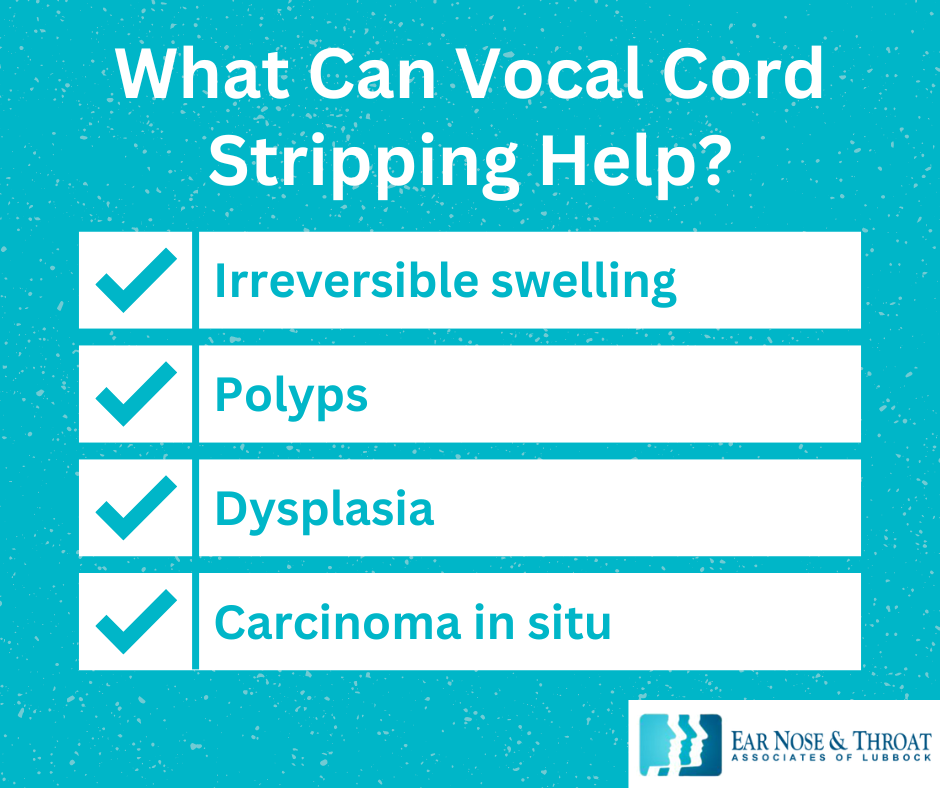Vocal Cord Stripping: Before, During, and After Your Procedure

If you’ve dealt with vocal cord conditions like irreversible swelling, polyps, or non-invasive cancer, you’re no stranger to the symptoms: chronic sore throat, difficulty speaking, or the irritating sensation of something stuck in your throat.
In certain cases, vocal cord stripping can be a safe and effective solution.
Let’s take a closer look at this procedure to find out what it is and how it can help.
What Is Vocal Cord Stripping and What Are the Benefits?
Your vocal cords are made up of two ligaments on either side of your larynx (or voice box), covered by muscle wrapped in a delicate, fine layer of mucosal tissue. This outer tissue can sometimes become damaged, inflamed, or diseased, necessitating vocal cord stripping.
Vocal cord stripping is a surgery that involves gently removing the outermost layer of vocal cord tissue when it has become irreversibly diseased. The process removes the damaged cells and allows new tissue to grow back healthier in its place.
We might recommend vocal cord stripping if you have specific vocal cord conditions, including:
- Irreversible swelling
- Polyps
- Dysplasia (abnormal, pre-cancerous cells)
- Carcinoma in situ (non-invasive cancer that hasn’t spread to the nearby tissues)
For instance, if you have dysplasia, which is abnormal, pre-cancerous cells on the vocal cord, vocal cord stripping removes those cells before they progress to cancer.

What Happens Before the Procedure?
Vocal cord stripping isn’t the first line of treatment. Depending on the ailment, we’ll recommend other, more conservative medical treatments for vocal cord issues first, such as:
- Antibiotics
- Antifungal medications
- Oral steroids
- Reflux medications
- Behavioral modifications like avoiding cigarettes and alcohol
If none of these treatments work and your vocal cords reach the point of irreversible damage, vocal cord stripping will likely be our next step.
What Happens During Vocal Cord Stripping?
Don’t worry — this procedure takes place under general anesthesia, so you won’t feel a thing!
Once the anesthesia takes effect, we insert a scope into your mouth to see your voice box and vocal cords under a microscope.
We then use long, tiny forceps to grasp the vocal cord and a pair of tiny micro-laryngeal scissors to strip off the damaged outer layer of delicate tissue containing the abnormal cells, taking care not to injure the deeper parts of the vocal cord.
The entire surgery takes about 15–30 minutes.
What Happens After Vocal Cord Stripping?
After vocal cord stripping, you’ll need complete vocal rest — or in other words, no talking — for three to seven days. Beyond that, you’ll also want to avoid abusing your voice with shouting or excessive talking for several months, since these activities strain your vocal cords.
Depending on the patient, we may recommend the following post-op treatments to help with healing and prevent future injury or disease:
- Speech therapy may help you develop practical vocal techniques to gradually recover your full voice function and avoid injuring your vocal cords in the future.
- Anti-reflux medications like Nexium can help prevent further injury to your vocal cords from stomach acid.
- Behavioral changes like stopping smoking or drinking will help your throat heal faster and help prevent the need for treatment again in the future.
Talk to Your Doctor to Find Out if Vocal Cord Stripping Is Right for You
If the delicate lining of your vocal cords becomes irreversibly damaged or diseased, it’s important to treat it for your comfort and health. If medications and behavioral changes fail, vocal cord stripping may be the best solution.
Always speak with your ENT about any vocal cord issues you’re having so you can find out the best next step for your health!
Dr. Scolaro is a board-certified Otolaryngologist servicing the South Plains area. He has been practicing in Lubbock since 1990 and has earned a reputation as a skilled and experienced surgeon. He currently serves as the Medical Director for Covenant High Plains Surgery Center campuses, is a member of Covenant Health Partners and is an adjunct faculty professor for Texas Tech University Health Sciences Center School of Medicine. Learn more about Dr. Scolaro.
Categories:








